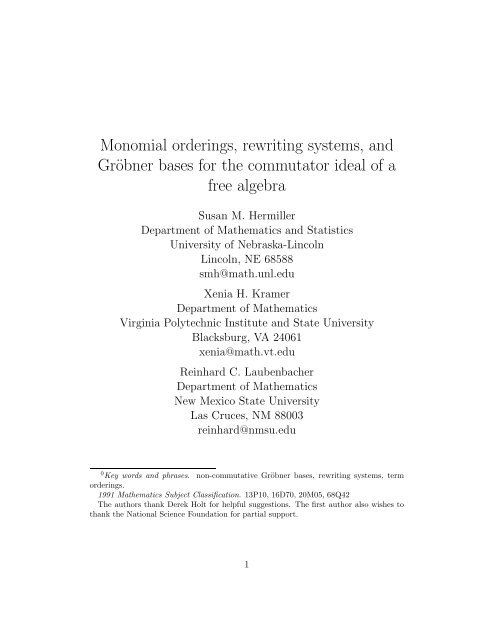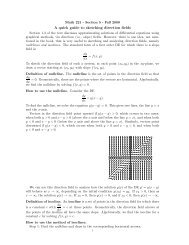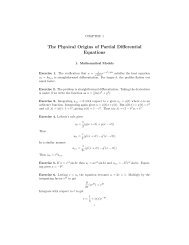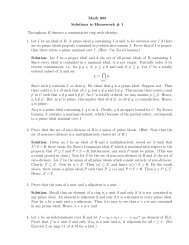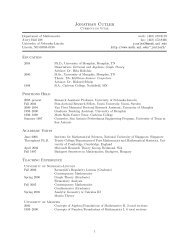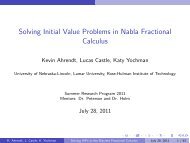Monomial orderings, rewriting systems, and Gröbner bases for the ...
Monomial orderings, rewriting systems, and Gröbner bases for the ...
Monomial orderings, rewriting systems, and Gröbner bases for the ...
You also want an ePaper? Increase the reach of your titles
YUMPU automatically turns print PDFs into web optimized ePapers that Google loves.
<strong>Monomial</strong> <strong>orderings</strong>, <strong>rewriting</strong> <strong>systems</strong>, <strong>and</strong><br />
<strong>Gröbner</strong> <strong>bases</strong> <strong>for</strong> <strong>the</strong> commutator ideal of a<br />
free algebra<br />
Susan M. Hermiller<br />
Department of Ma<strong>the</strong>matics <strong>and</strong> Statistics<br />
University of Nebraska-Lincoln<br />
Lincoln, NE 68588<br />
smh@math.unl.edu<br />
Xenia H. Kramer<br />
Department of Ma<strong>the</strong>matics<br />
Virginia Polytechnic Institute <strong>and</strong> State University<br />
Blacksburg, VA 24061<br />
xenia@math.vt.edu<br />
Reinhard C. Laubenbacher<br />
Department of Ma<strong>the</strong>matics<br />
New Mexico State University<br />
Las Cruces, NM 88003<br />
reinhard@nmsu.edu<br />
0Key words <strong>and</strong> phrases. non-commutative <strong>Gröbner</strong> <strong>bases</strong>, <strong>rewriting</strong> <strong>systems</strong>, term<br />
<strong>orderings</strong>.<br />
1991 Ma<strong>the</strong>matics Subject Classification. 13P10, 16D70, 20M05, 68Q42<br />
The authors thank Derek Holt <strong>for</strong> helpful suggestions. The first author also wishes to<br />
thank <strong>the</strong> National Science Foundation <strong>for</strong> partial support.<br />
1
Abstract<br />
In this paper we consider a free associative algebra on three generators<br />
over an arbitrary field K. Given a term ordering on <strong>the</strong> commutative<br />
polynomial ring on three variables over K, we construct uncountably<br />
many liftings of this term ordering to a monomial ordering<br />
on <strong>the</strong> free associative algebra. These monomial <strong>orderings</strong> are total<br />
well <strong>orderings</strong> on <strong>the</strong> set of monomials, resulting in a set of normal<br />
<strong>for</strong>ms. Then we show that <strong>the</strong> commutator ideal has an infinite reduced<br />
<strong>Gröbner</strong> basis with respect to <strong>the</strong>se monomial <strong>orderings</strong>, <strong>and</strong><br />
all initial ideals are distinct. Hence, <strong>the</strong> commutator ideal has at least<br />
uncountably many distinct reduced <strong>Gröbner</strong> <strong>bases</strong>. A <strong>Gröbner</strong> basis<br />
of <strong>the</strong> commutator ideal corresponds to a complete <strong>rewriting</strong> system<br />
<strong>for</strong> <strong>the</strong> free commutative monoid on three generators; our result also<br />
shows that this monoid has at least uncountably many distinct minimal<br />
complete <strong>rewriting</strong> <strong>systems</strong>.<br />
The monomial <strong>orderings</strong> we use are not compatible with multiplication,<br />
but are sufficient to solve <strong>the</strong> ideal membership problem<br />
<strong>for</strong> a specific ideal, in this case <strong>the</strong> commutator ideal. We propose<br />
that it is fruitful to consider such more general monomial <strong>orderings</strong> in<br />
non-commutative <strong>Gröbner</strong> basis <strong>the</strong>ory.<br />
1 Introduction<br />
Let K be a field, let Σ = {a, b, c}, <strong>and</strong> let A = K〈a, b, c〉 be <strong>the</strong> free associative<br />
algebra over K on Σ. Let<br />
γ : K〈a, b, c〉 −→ K[x, y, z]<br />
be <strong>the</strong> projection modulo <strong>the</strong> commutator ideal<br />
I = (ab − ba, ac − ca, bc − cb).<br />
In this paper we construct, <strong>for</strong> a given term ordering < on K[x, y, z], an uncountable<br />
family of monomial <strong>orderings</strong> on A, which lift
monomials in <strong>the</strong> free algebra are compared by first comparing <strong>the</strong>ir projections<br />
to <strong>the</strong> polynomial ring. If those are equal, <strong>the</strong>n <strong>the</strong> words are compared<br />
lexicographically. The authors also lift <strong>the</strong> ideal I to an ideal in <strong>the</strong> free algebra<br />
by adding <strong>the</strong> commutator relations. A main result in [1] is that, after<br />
a generic change of coordinates in K[x1, . . .,xn], <strong>the</strong> lifted ideal in <strong>the</strong> free<br />
algebra has a finite <strong>Gröbner</strong> basis. The idea of studying ideals in commutative<br />
polynomial rings by considering a non-commutative presentation arises<br />
from work on <strong>the</strong> homology of coordinate rings of Grassmanians <strong>and</strong> toric<br />
varieties. See also [6]. One can now ask what happens if one chooses more<br />
exotic liftings of <strong>the</strong> commutative term ordering.<br />
In <strong>the</strong> present paper, we construct o<strong>the</strong>r types of liftings. For each commutative<br />
term ordering on K[x, y, x], we give uncountably many liftings to<br />
K〈a, b, c〉. We <strong>the</strong>n consider <strong>the</strong> commutator ideal, that is, <strong>the</strong> lifting of <strong>the</strong><br />
zero ideal to <strong>the</strong> free algebra, <strong>and</strong> study its <strong>Gröbner</strong> <strong>bases</strong> with respect to<br />
<strong>the</strong> lifted monomial <strong>orderings</strong>. It is our hope that <strong>the</strong>se monomial <strong>orderings</strong><br />
will prove useful in applications to commutative problems.<br />
Two central features of <strong>Gröbner</strong> basis <strong>the</strong>ory, both commutative <strong>and</strong> noncommutative,<br />
are that it provides a set of normal <strong>for</strong>ms <strong>and</strong> allows <strong>the</strong> solution<br />
of <strong>the</strong> ideal membership problem. In order to obtain both <strong>the</strong>se features<br />
<strong>for</strong> a given ideal <strong>and</strong> a given set of generators it is not required that one<br />
start with a term ordering, that is, a total well-founded ordering on <strong>the</strong> set<br />
of monomials which is compatible with multiplication. If <strong>the</strong> Buchberger or<br />
Mora algorithm is per<strong>for</strong>med with an ordering that is well-founded, <strong>and</strong> a set<br />
of generators <strong>for</strong> <strong>the</strong> ideal is created by this algorithm <strong>for</strong> which <strong>the</strong> reduction<br />
process modulo this set always terminates after finitely many steps in a normal<br />
<strong>for</strong>m, <strong>the</strong>n this generating set will solve <strong>the</strong> ideal membership problem<br />
<strong>and</strong> give a set of normal <strong>for</strong>ms. It is not even necessary that <strong>the</strong> ordering<br />
be total. We believe that it might be very fruitful to study such “weak term<br />
<strong>orderings</strong>” <strong>for</strong> free algebras. In <strong>the</strong> commutative case, one does not actually<br />
obtain anything new, since each weak term ordering can be replaced by an<br />
actual term ordering with <strong>the</strong> same normal <strong>for</strong>ms [8]. This paper shows that<br />
<strong>the</strong> result in [8] does not generalize to <strong>the</strong> noncommutative case.<br />
One of <strong>the</strong> fundamental results in commutative <strong>Gröbner</strong> basis <strong>the</strong>ory is<br />
that every ideal in a polynomial ring has only finitely many initial ideals<br />
(see, e.g., [9, Thm. 1.2]). It is well known that this result is false in <strong>the</strong><br />
non-commutative <strong>the</strong>ory. A survey of counterexamples can be found in [2].<br />
We show that <strong>the</strong> initial ideals of <strong>the</strong> commutator ideal in A with respect<br />
to our monomial <strong>orderings</strong> are all distinct, so that <strong>the</strong> commutator ideal has<br />
3
at least uncountably many initial ideals, answering an open question in [2].<br />
Since <strong>the</strong> difference between <strong>the</strong> commutative <strong>and</strong> non-commutative cases is<br />
<strong>the</strong> commutator ideal, it is not surprising that <strong>the</strong> differences between <strong>the</strong><br />
two <strong>the</strong>ories should manifest <strong>the</strong>mselves <strong>the</strong>re.<br />
Since <strong>the</strong> commutator ideal is a binomial ideal with each generator consisting<br />
of <strong>the</strong> difference of two monomials, <strong>the</strong> quotient ring is <strong>the</strong> monoid<br />
ring over K <strong>for</strong> <strong>the</strong> free commutative monoid on three generators. Thus <strong>the</strong><br />
Mora algorithm <strong>for</strong> <strong>the</strong> commutator ideal <strong>and</strong> <strong>the</strong> Knuth-Bendix algorithm<br />
<strong>for</strong> <strong>the</strong> monoid will produce <strong>the</strong> same set of normal <strong>for</strong>ms if <strong>the</strong>y start with<br />
<strong>the</strong> same ordering. So our <strong>the</strong>orem also shows that <strong>for</strong> <strong>the</strong> free commutative<br />
monoid on three generators, <strong>the</strong>re are uncountably many distinct minimal<br />
complete <strong>rewriting</strong> <strong>systems</strong> with respect to our <strong>orderings</strong>.<br />
All of <strong>the</strong> possible term <strong>orderings</strong> on <strong>the</strong> set of words over two generators<br />
have been classified in [4], [5], <strong>and</strong> [7]. While we have developed many<br />
more <strong>orderings</strong> <strong>for</strong> words over three letters, we do not know if repeating<br />
our constructions would allow us to find all of <strong>the</strong> <strong>Gröbner</strong> <strong>bases</strong> <strong>for</strong> <strong>the</strong><br />
commutator ideal. It would be of interest to attempt <strong>the</strong> classification of all<br />
term <strong>orderings</strong> <strong>for</strong> three letters to answer this question.<br />
2 <strong>Gröbner</strong> Bases <strong>and</strong> Rewriting Systems<br />
Since <strong>the</strong> results in this paper can be interpreted both in <strong>the</strong> framework<br />
of <strong>Gröbner</strong> basis <strong>the</strong>ory <strong>and</strong> that of <strong>rewriting</strong> <strong>systems</strong>, we give here a brief<br />
summary of relevant definitions <strong>and</strong> <strong>the</strong>ir relationship.<br />
Let K be a field, let Σ be a finite set, let Σ ∗ be <strong>the</strong> free monoid on Σ,<br />
<strong>and</strong> let A = K〈Σ〉 = K[Σ ∗ ] be <strong>the</strong> free associative algebra over K on Σ.<br />
A <strong>rewriting</strong> system over Σ is a set R ⊆ Σ ∗ × Σ ∗ of replacement rules,<br />
where an element (or rule) (u, v) ∈ R is also written u → v. In general,<br />
if u → v, <strong>the</strong>n whenever <strong>the</strong> word u appears inside a larger word, we will<br />
replace it with <strong>the</strong> word v; that is, <strong>for</strong> any x, y ∈ Σ ∗ , we write xuy → xvy<br />
<strong>and</strong> say that <strong>the</strong> word xuy is rewritten (or reduced) to <strong>the</strong> word xvy. An<br />
element x ∈ Σ ∗ is irreducible or in normal <strong>for</strong>m if it cannot be rewritten.<br />
The ordered pair (Σ, R) is a <strong>rewriting</strong> system <strong>for</strong> a monoid M if<br />
is a presentation <strong>for</strong> M.<br />
〈 Σ | u = v if (u, v) ∈ R 〉<br />
4
A <strong>rewriting</strong> system (Σ, R) is terminating if <strong>the</strong>re is no infinite chain x →<br />
x1 → x2 → · · · of <strong>rewriting</strong>s; that is, if <strong>the</strong> partial ordering defined by x ≥ y<br />
whenever x → · · · → y is well-founded. R is confluent if whenever a word<br />
x can be rewritten in two different ways to words y1 <strong>and</strong> y2, <strong>the</strong>n <strong>the</strong>re are<br />
<strong>rewriting</strong>s from y1 <strong>and</strong> y2 to a common word z. When R is terminating,<br />
confluence is equivalent to saying that <strong>the</strong>re is exactly one irreducible word<br />
representing each element of <strong>the</strong> monoid presented by <strong>the</strong> <strong>rewriting</strong> system.<br />
The system R is complete if it is both terminating <strong>and</strong> confluent. Finally, it<br />
is minimal if each right h<strong>and</strong> side, <strong>and</strong> each proper subword of a left h<strong>and</strong><br />
side, of a rule is irreducible.<br />
In this paper we will use <strong>the</strong> expression monomial ordering to denote<br />
a partial well-founded ordering on a set of monomials. A term ordering<br />
is a monomial ordering with <strong>the</strong> additional properties that it is total <strong>and</strong><br />
compatible with multiplication; that is, whenever x < y in <strong>the</strong> ordering,<br />
<strong>the</strong>n wxz < wyz also.<br />
Let < be a monomial ordering on K〈Σ〉. If f ∈ K〈Σ〉, <strong>the</strong> largest monomial<br />
of f with respect to < is its leading term. A <strong>Gröbner</strong> basis <strong>for</strong> an ideal<br />
I of A is a subset G of I such that <strong>the</strong> ideal generated by <strong>the</strong> leading terms<br />
of elements in G is equal to <strong>the</strong> ideal generated by <strong>the</strong> leading terms of all<br />
elements of I. A <strong>Gröbner</strong> basis G is reduced, if no term of any polynomial in<br />
G is divisible by <strong>the</strong> leading term of a polynomial in G. In <strong>the</strong> following result<br />
we state <strong>the</strong> relationship between <strong>rewriting</strong> <strong>systems</strong> <strong>and</strong> <strong>Gröbner</strong> <strong>bases</strong>.<br />
Its proof is straight<strong>for</strong>ward.<br />
Theorem 2.1 Suppose M is <strong>the</strong> free commutative monoid generated by<br />
Σ = {a, b, c}. Let R be a minimal complete <strong>rewriting</strong> system <strong>for</strong> M, <strong>and</strong> let<br />
G = {u − v | u → v ∈ R}.<br />
Then G is a reduced <strong>Gröbner</strong> basis <strong>for</strong> <strong>the</strong> commutator ideal I of A.<br />
The <strong>Gröbner</strong> <strong>bases</strong> of I corresponding to distinct <strong>rewriting</strong> <strong>systems</strong> of M<br />
are also distinct. For more details on <strong>rewriting</strong> <strong>systems</strong>, <strong>Gröbner</strong> <strong>bases</strong>, <strong>and</strong><br />
<strong>the</strong> connections between <strong>the</strong>m <strong>for</strong> monoid rings, see [3].<br />
3 <strong>Monomial</strong> Orderings <strong>and</strong> Initial Ideals<br />
Let<br />
γ : A = K〈a, b, c〉 −→ K[x, y, z]<br />
5
e <strong>the</strong> canonical projection with kernel <strong>the</strong> commutator ideal I. In this<br />
section we will prove <strong>the</strong> following <strong>the</strong>orem.<br />
Theorem 3.1 Let < be a term ordering on K[x, y, z]. There exist mono-<br />
) ⊂ R,<br />
mial <strong>orderings</strong> ≺r on A = K〈a, b, c〉, <strong>for</strong> each r in <strong>the</strong> interval (0, 1<br />
2<br />
which are liftings of
First consider <strong>the</strong> case that <strong>the</strong>re are only finitely many such indices mj,<br />
with mJ being <strong>the</strong> largest one. Set mj = ∞, if j > J. In this case we have<br />
rules (4 j ) <strong>for</strong> 1 ≤ j ≤ J + 1 <strong>and</strong> rules (5 j ) <strong>for</strong> 1 ≤ j ≤ J. Note that in this<br />
case, <strong>the</strong> <strong>rewriting</strong> system has <strong>the</strong> additional property that it is regular, in<br />
<strong>the</strong> sense that <strong>the</strong> set of word pairs given by <strong>the</strong> left <strong>and</strong> right h<strong>and</strong> sides<br />
of rules is a regular language accepted by a finite state automaton. The<br />
normal <strong>for</strong>ms associated to <strong>the</strong> <strong>rewriting</strong> system are <strong>the</strong>re<strong>for</strong>e also a regular<br />
language.<br />
To each word w in Σ ∗ we associate an integer vector Ψ(w) as follows.<br />
Each of <strong>the</strong> entries of this vector Ψ(w) will be a “barrier ordering”; we will<br />
place barriers in w, <strong>and</strong> <strong>the</strong>n use <strong>the</strong>se barriers to associate a number to w.<br />
To define <strong>the</strong> first entry α(w) of Ψ(w), insert barriers in w to immediate<br />
<strong>the</strong> right of every letter c that occurs. For instance, if w = abc 2 baca, <strong>the</strong>n<br />
we place barriers as follows:<br />
w = abc|c|bac|a.<br />
Let lb(i) denote <strong>the</strong> number of occurrences of b to <strong>the</strong> left of <strong>the</strong> i-th barrier<br />
in w. Suppose <strong>the</strong>re are n barriers in w. Now define<br />
α(w) = lb(1) + · · · + lb(n).<br />
For <strong>the</strong> example w = abc 2 baca above, we have<br />
α(w) = 1 + 1 + 2 = 4.<br />
The o<strong>the</strong>r entries of Ψ(w) are defined similarly, but <strong>the</strong> barriers will be<br />
placed after certain types of subwords ra<strong>the</strong>r than individual letters. First we<br />
introduce some notation. Given any word t in Σ ∗ , let ˜t be <strong>the</strong> word obtained<br />
from t by deleting all occurrences of a in t, <strong>and</strong> let la(t) denote <strong>the</strong> number<br />
of occurrences of a in t. Suppose s is a word involving just <strong>the</strong> letters b <strong>and</strong><br />
c, <strong>and</strong> w is a word in Σ ∗ as above. We can write<br />
w = v1s1v2s2...skvk+1<br />
where:<br />
(i) ˜si = s,<br />
(ii) if ti is a proper subword of si <strong>the</strong>n ˜ti = s, <strong>and</strong><br />
(iii) k is maximal.<br />
7
As in <strong>the</strong> definition of α, insert barriers into w immediately to <strong>the</strong> right<br />
side of each subword si; <strong>the</strong>n count <strong>the</strong> number of occurrences of a to <strong>the</strong><br />
left of each barrier; that is, define<br />
k<br />
L(s, w) = la(v1s1...visi).<br />
i=1<br />
Similarly, define<br />
k<br />
R(s, w) = la(sivi+1...skvk+1),<br />
i=1<br />
placing barriers to <strong>the</strong> left of each subword si <strong>and</strong> counting <strong>the</strong> number of<br />
a’s to <strong>the</strong> right of <strong>the</strong> barriers.<br />
Finally, define <strong>the</strong> vector Ψ(w) by<br />
Ψ(w) = (α(w), L(c mJ b J+1 , w), R(c mJ b J , w), ..., L(c m1 b 2 , w), R(c m1 b, w), L(cb, w)).<br />
We are now ready to define <strong>the</strong> ordering ≺r on Σ ∗ , using <strong>the</strong> commutative<br />
ordering < via <strong>the</strong> projection<br />
γ : K〈a, b, c〉 = K[Σ ∗ ] −→ K[x, y, z],<br />
<strong>and</strong> <strong>the</strong> lexicographic ordering on <strong>the</strong> integer vector Ψ(w) associated to a<br />
word w. We assume, without loss of generality (by relabeling <strong>the</strong> letters<br />
a, b, c), that y < x < z in K[x, y, z], so that b ≺r a ≺r c.<br />
Now let w, w ′ be two words.<br />
Definition 3.3 Let w ≺r w ′ if<br />
1. γ(w) < γ(w ′ ), or<br />
2. γ(w) = γ(w ′ ) <strong>and</strong> Ψ(w)
Then<br />
We may write w as<br />
w = c|ac|b 2 c|ac|c|ac|bab 2 c|;<br />
α(w) = 0 + 0 + 2 + 2 + 2 + 2 + 5 = 13.<br />
To compute L(c 4 b 3 , w), write v1 = cacb 2 , s1 = cac 2 acbab 2 , <strong>and</strong> v2 = c.<br />
Then w = v1s1v2, ˜s1 = c 4 b 3 , <strong>and</strong> conditions (i)–(iii) are met. In this case,<br />
L(c 4 b 3 , w) = la(v1s1) = 4.<br />
Computing R(c 4 b 2 , w) next, write v1 = cacb 2 , s1 = cac 2 acbab, <strong>and</strong> v2 = bc.<br />
Again w = v1s1v2, but this time ˜s1 = c 4 b 2 , <strong>and</strong> conditions (i)-(iii) in <strong>the</strong><br />
definition of R(c 4 b 2 , w) are met. In this case,<br />
R(c 4 b 2 , w) = la(s1v2) = 3.<br />
The decomposition of w to compute L(c 2 b 2 , w) is given by w = v1s1v2s2v3<br />
where v1 = 1 (<strong>the</strong> empty word), s1 = cacb 2 , v2 = cac, s2 = cacbab, <strong>and</strong><br />
v3 = bc. Thus<br />
L(c 2 b 2 , w) = la(v1s1) + la(v1s1v2s2) = 1 + 4 = 5.<br />
Similar computations give R(c 2 b, w) = 6 <strong>and</strong> L(cb, w) = 4. Assembling<br />
<strong>the</strong>se numbers, we obtain<br />
Ψ(w) = (13, 4, 3, 5, 6, 4).<br />
Proposition 3.5. The partial ordering ≺r is a well-founded total ordering.<br />
Fur<strong>the</strong>rmore, <strong>the</strong> set Rr is a minimal complete <strong>rewriting</strong> system <strong>for</strong> <strong>the</strong><br />
free commutative monoid M with respect to ≺r.<br />
Proof. We first show that <strong>the</strong> ordering is well-founded. The ordering<br />
< on commutative polynomials is a term ordering, so it is well-founded. In<br />
Definition 3.3, Ψ(w) <strong>and</strong> Ψ(w ′ ) have <strong>the</strong> same length, so we can replace<br />
<strong>the</strong> ordering
<strong>the</strong> well-founded ordering L(c mj b j+1 , w ′ ).<br />
Similarly, applying a rule of <strong>the</strong> <strong>for</strong>m (5 j ), j ≤ J leaves α(w) = α(w ′ ),<br />
L(c mJ b J+1 , w) = L(c mJ b J+1 , w ′ ), R(c mJ b J , w) = R(c mJ b J , w ′ ),..., L(c mj+1 b j+2 , w) =<br />
L(c mj+1 b j+2 , w ′ ), <strong>and</strong> R(c mj b j , w) > R(c mj b j , w ′ ). In each case, <strong>the</strong>n, <strong>the</strong> rules<br />
(4 j ), (5 j ) decrease Ψ, <strong>and</strong> if one of <strong>the</strong>se rules is applied to rewrite w to w ′ ,<br />
<strong>the</strong>n w ′ ≺r w.<br />
Finally, if rule (1) or (3) is applied to w, <strong>the</strong>n α(w ′ ) = α(w). For each<br />
index j, applying rule (1) or (3) ei<strong>the</strong>r does not move past a barrier used to<br />
compute L(c mj b j+1 , ·) or R(c mj b j , ·), or else it moves an a past a barrier in a<br />
way that will decrease <strong>the</strong> corresponding variable. There<strong>for</strong>e Ψ(w ′ ) ≤ Ψ(w).<br />
However, <strong>rewriting</strong> by (1) <strong>and</strong> (3) decreases w lexicographically, since b ≺r<br />
a ≺r c, so w ′ ≺r w. Thus, we have shown that <strong>the</strong> reduction process always<br />
decreases <strong>the</strong> well-founded ordering ≺r no matter what rule is applied, so<br />
this process will always terminate after finitely many steps.<br />
10
Next we show that <strong>the</strong> reduction process results in normal <strong>for</strong>ms. This is<br />
straight<strong>for</strong>ward to verify by showing that Rr is confluent. To obtain <strong>the</strong> set<br />
of normal <strong>for</strong>ms explicitly, let w be a word, which we write as<br />
w = w1(a, c)bw2(a, c)b · · ·bwn(a, c),<br />
where <strong>the</strong> subwords wi(a, c) do not contain b. Using rule (3), we can rewrite<br />
each wm in <strong>the</strong> <strong>for</strong>m aick . Now, using rules (1)-(3) <strong>and</strong> (6i ), it is straight<strong>for</strong>ward<br />
to check that we can rewrite w to w ′ = aickbjai′ . To rewrite w ′ fur<strong>the</strong>r,<br />
we consider three cases.<br />
First suppose that j = 0; <strong>the</strong>n applying rule (3) repeatedly rewrites w ′<br />
to <strong>the</strong> <strong>for</strong>m aick . Next suppose that j ≥ 1 <strong>and</strong> k < mj. Let 1 ≤ j ′ ≤ j be an<br />
integer such that mj ′ −1 ≤ k < mj ′. Then<br />
<strong>and</strong> we can rewrite w ′ to c k b j a i+i′<br />
<strong>and</strong> k ≥ mj, <strong>the</strong>n we write<br />
w ′ = (a i c k b j′<br />
)b j−j′<br />
a i′<br />
,<br />
using rules (4j′ ) <strong>and</strong> (1). Finally, if j ≥ 1<br />
w ′ = a i c k−mj (c mj b j a i ′<br />
),<br />
which we can rewrite to ai+i′ ckbj , using rules (5j ) <strong>and</strong> (3). Thus, <strong>the</strong> set of<br />
normal <strong>for</strong>ms is<br />
{a i c k |i, k ≥ 0}∪{c k b j a i |i, k ≥ 0, j ≥ 1, <strong>and</strong>k < mj}∪{a i c k b j |i, k ≥ 0, j ≥ 1, <strong>and</strong>k ≥ mj}.<br />
This completes <strong>the</strong> proof of <strong>the</strong> proposition.<br />
Remark. What keeps ≺r from being a term ordering in <strong>the</strong> usual sense<br />
is that it is not compatible with multiplication. As an example, let r = .001,<br />
so that J = 1, m0 = 1, m1 = 3. Let u = c 2 , w = cab 2 a <strong>and</strong> w ′ = cba 2 b. Then<br />
γ(w) = γ(w ′ ), <strong>and</strong><br />
Ψ(w) = (0, 0, 0, 1) > (0, 0, 0, 0) = Ψ(w ′ ),<br />
so that w ′ ≺1 w. But γ(uw) = γ(uw ′ ), <strong>and</strong><br />
Ψ(uw) = (0, 1, 2, 1) < (0, 2, 2, 0) = Ψ(uw ′ ).<br />
In <strong>the</strong> proof of Theorem 3.2, it remains to consider <strong>the</strong> case of infinitely<br />
many 1’s in <strong>the</strong> binary expansion of r. To define <strong>the</strong> ordering ≺r in this case,<br />
11
suppose that w <strong>and</strong> w ′ are any words, <strong>and</strong> let l be <strong>the</strong> length of <strong>the</strong> longest<br />
of <strong>the</strong> two words. Let r ′ be <strong>the</strong> real number whose first l binary digits are<br />
<strong>the</strong> same as those of r, <strong>and</strong> whose remaining digits are all zero. (Replace<br />
<strong>the</strong> (l + 1)st digit with a 1, if necessary, to be sure that 0 < r ′ < .1 = 1<br />
Then define w ′ ≺r w if w ′ ≺r ′ w. This automatically gives <strong>the</strong> property<br />
′. Note that<br />
that w ′ ≺r w whenever γ(w ′ ) < γ(w), since this is true <strong>for</strong> ≺r<br />
if 0 < r ′ < r ′′ < .1 <strong>and</strong> both have finite binary expansions whose first l<br />
digits agree, <strong>the</strong>n w ′ ≺r ′ w if <strong>and</strong> only if w′ ≺r ′′ w; in o<strong>the</strong>r words, our<br />
<strong>orderings</strong> ≺r behave well under <strong>for</strong>mation of limits of <strong>the</strong> numbers r. This<br />
implies that any infinite chain w1 ≻r w2 ≻r · · · corresponds to an infinite<br />
chain w1 ≻r ′ w2 ≻r ′ · · · <strong>for</strong> a real number 0 < r′ < .1 with a finite binary<br />
expansion. Well-foundedness of <strong>the</strong> ordering ≺r <strong>the</strong>n follows from <strong>the</strong> wellfoundedness<br />
of <strong>the</strong> <strong>orderings</strong> ≺r ′ in Proposition 3.5.<br />
For any given word w of length l, <strong>the</strong> rules of Rr which can be applied in<br />
<strong>the</strong> process of reducing w to its normal <strong>for</strong>m must also appear in Rr ′; application<br />
of <strong>the</strong>se rules strictly decreases <strong>the</strong> ordering ≺r. Thus we can truncate<br />
<strong>the</strong> binary expansion of r after a finite number of 1’s, <strong>and</strong> we can proceed as<br />
in <strong>the</strong> case of a finite binary expansion treated above; <strong>the</strong> reduction process<br />
on w must terminate after finitely many steps.<br />
Finally, to show that <strong>the</strong> reduction process results in normal <strong>for</strong>ms in<br />
<strong>the</strong> case when <strong>the</strong> expansion <strong>for</strong> r contains infinitely many 1’s, we can again<br />
verify this by checking that Rr is confluent.<br />
In summary, we have established a one-to-one correspondence between<br />
all real numbers in <strong>the</strong> interval (0, 1)<br />
<strong>and</strong> monomial <strong>orderings</strong>, or weak term<br />
2<br />
<strong>orderings</strong>, on <strong>the</strong> free monoid Σ∗ . With respect to <strong>the</strong> monomial ordering<br />
≺r, <strong>the</strong> free commutative monoid M has <strong>the</strong> minimal complete <strong>rewriting</strong><br />
system Rr defined above. Since Rr = Rr ′ if r = r′ , we have established a<br />
one-to-one correspondence between <strong>the</strong> set of real numbers in (0, 1)<br />
<strong>and</strong> a set<br />
2<br />
of complete <strong>rewriting</strong> <strong>systems</strong> of M. This completes <strong>the</strong> proof of Theorem<br />
3.2 <strong>and</strong> <strong>the</strong>re<strong>for</strong>e also that of Theorem 3.1.<br />
References<br />
[1] D. Eisenbud, I. Peeva, <strong>and</strong> B. Sturmfels, Non-commutative <strong>Gröbner</strong><br />
<strong>bases</strong> <strong>for</strong> commutative algebras , Proc. Amer. Math. Soc. 126 (1998)<br />
687–691.<br />
12<br />
2 .)
[2] E. Green, T. Mora <strong>and</strong> V. Ufnarovski, The non-commutative <strong>Gröbner</strong><br />
freaks, in Symbolic Rewriting Techniques (Ascona, 1995), 93–104,<br />
Progr. Comput. Sci. Appl. Logic 15, Birkhäuser, Basel, 1998.<br />
[3] K. Madelener <strong>and</strong> B. Reinert, String <strong>rewriting</strong> <strong>and</strong> <strong>Gröbner</strong> <strong>bases</strong><br />
– a general approach to monoid <strong>and</strong> group rings, Symbolic Rewriting<br />
Techniques (Ascona, 1995), 127–180, Progr. Comput. Sci. Appl. Logic<br />
15, Birkhäuser, Basel, 1998.<br />
[4] U. Martin <strong>and</strong> E. Scott, The order types of termination <strong>orderings</strong> on<br />
monadic terms, strings <strong>and</strong> multisets, Eighth Annual IEEE Symposium<br />
on Logic in Computer Science (Montreal, PQ, 1993), 356-363,<br />
IEEE Comput. Soc. Press, Los Alamitos, CA, 1993.<br />
[5] Martin <strong>and</strong> E. Scott, The order types of termination <strong>orderings</strong> on<br />
monadic terms, strings <strong>and</strong> multisets, J. Symbolic Logic 62 (1997)<br />
624–635.<br />
[6] I. Peeva, V. Reiner <strong>and</strong> B. Sturmfels, How to shell a monoid, Math.<br />
Ann. 310 (1998) 379–393.<br />
[7] S. Perlo-Freeman <strong>and</strong> P. Pröhle, Scott’s conjecture is true, position<br />
sensitive weights, Rewriting Techniques <strong>and</strong> Applications (Sitges,<br />
1997), 217–227, Lecture Notes in Comput. Sci., 1232, Springer,<br />
Berlin, 1997.<br />
[8] A. Reeves <strong>and</strong> B. Sturmfels, A note on polynomial reduction, J. Symbolic<br />
Comput. 16 (1993) 273–277.<br />
[9] B. Sturmfels, <strong>Gröbner</strong> Bases <strong>and</strong> Convex Polytopes, University Lecture<br />
Series 8, American Ma<strong>the</strong>matical Society, Providence, R. I., 1996.<br />
13


